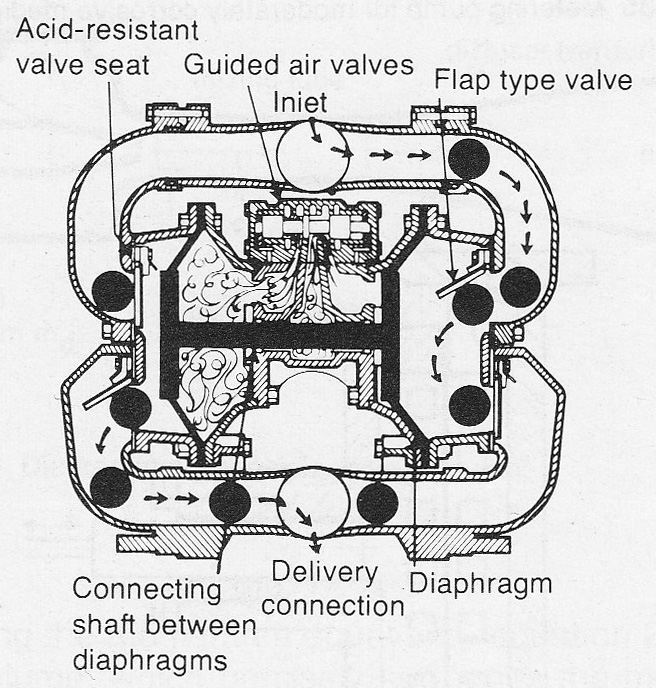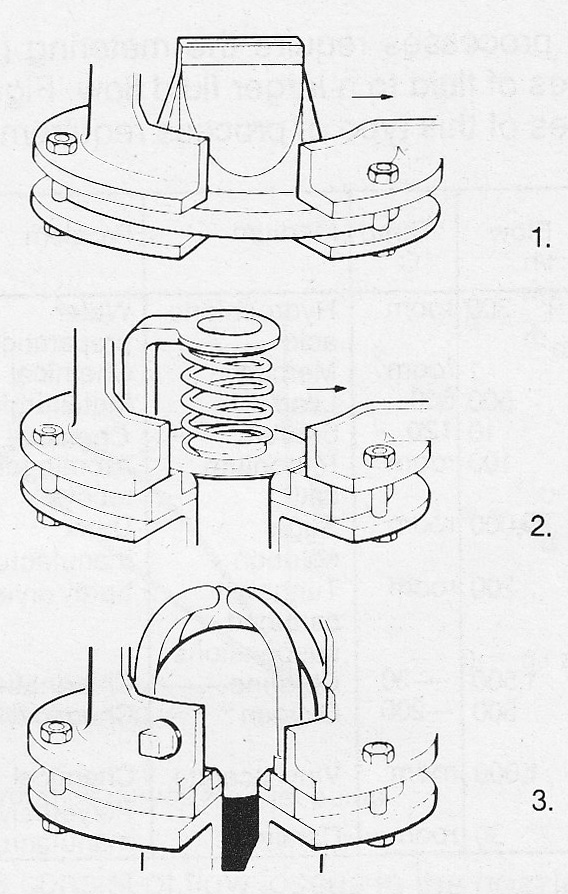3.4.8 Diaphragm pump
Diaphragm pump
A Diaphragm pump is a reciprocating pump where the working element is a flexible diaphragm. The drive can be by means of a crank driven by an electric motor or by means of compressed air acting directly upon the diaphragm figure 3.48a. Two valves, one on the delivery and one on the suction side, are necessary. Several types of valves are used, the most common being the ball type, which is sometimes spring-loaded. Other types of valves are flap, poppet, disc and flexible “nozzle” valves, see figure 3.48b.

Figure 3.48a. Compressed air driven diaphragm pump.
Diaphragm pumps are leak-free since they have no shafts which pass through the pumping chamber. Leakage can however occur if the diaphragm breaks. It is therefore necessary to replace the diaphragms in the course of preventative servicing so as to avoid sudden leakage.

Figure 3.48b Types of valves used for diaphragm pumps. From the top: 1) nozzle, 2) disc and 3) ball valve.
The material used for the diaphragm is usually an elastomer (rubber) such as nitrile rubber, neoprene rubber and fluorocarbon. The diaphragm material limits the temperature of the fluid to about 100°C, although temperatures of up to 200°C can be permitted if a PTFE diaphragm is used.
Diaphragm pumps have good suction capabilities varying from between 1-8 m depending upon the size of the pump, speed of stroke and type of valves. With the exception of the smaller pumps, diaphragm pumps can be used to handle practically any kind of fluid, fluent, viscous, clean or heavily contaminated. The type of valve, however, often imposes limitations upon the maximum size of contaminant particle which can pass through the pump. Flap valves allow the largest particles and a pump having 50 mm connections can. if fitted with flap valves, handle particles of 40-45 mm in diameter.
Diaphragm pumps always produce a pulsating flow. The pulsations can be reduced by fitting pressure equalizers e.g. pulsation dampers (also known as rubber bladder ackumulators) after the pump. Volume flow rates can vary between 0,4 and 300 m³/h. Pump casings are made of aluminium, cast iron, acid-resistant steel or plastics. Pumps driven by compressed air can, unlike other positive displacement pumps, run towards a closed valve (zero flow). The maximum working pressure (head) for such a pump is the compressed air pressure minus losses, efficiency, to overcome movement of mechanical parts and fluid (friction).
Small diaphragm pumps are constructed differently and are mostly used for metering purposes. They are driven by electric motor via a crank shaft or cam disc. The stroke and speed are usually adjustable so as to facilitate regulation of the pump to its desired capacity. Pumps are often fitted with double spring-loaded ball valves in both the suction and delivery lines in order to reduce the risk of feed-back through the valve after each respective suction and delivery stroke.
Diaphragm metering pumps are only suitable for clean and fluent fluids. In order to maintain precision the pump must be located so as to receive a constant supply pressure. The choice of diaphragm materials is similar to that for other types of diaphragm pumps. PTFE diaphragms are often corrugated or bellows-shaped to compensate for their reduced flexibility. Pump casings are of acid-resistant steel or plastic. Volume flow rates can be as little as a few cm³/24 hours.
